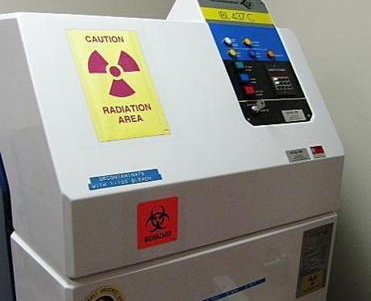Replacing Cesium-137 Blood Irradiators
Part of Preventing a Dirty Bomb: Radiological Security for Hospitals and Research Centers

About the image
Hospitals and research centers in the United States and around the world are addressing concerns about radiological security, safety and liability by replacing blood irradiators that use radioactive cesium-137 with safe, effective, FDA-approved x-ray technology.
In addition to the important health and safety concerns associated with a radiological attack, hospitals and research centers face considerable liability and reputation risks. Replacing cesium-137 source-based devices with X-ray technology protects those without insurance to cover losses associated with acts of terrorism—losses that easily could cause financial devastation for an institution responsible for paying huge damages in the wake of a dirty bomb explosion using stolen material.
 If an institution chooses to continue using cesium-137 devices, those who oversee operations including radiation, health, safety and security department, have an obligation to ensure the devices are used in a safe and secure matter, compliant with state and/or federal regulations. They also must inform senior management about risks associated with the devices. End users, including doctors, technicians, and researchers, also should be informed about security risks and threats, and provided with information about alternative technologies.
If an institution chooses to continue using cesium-137 devices, those who oversee operations including radiation, health, safety and security department, have an obligation to ensure the devices are used in a safe and secure matter, compliant with state and/or federal regulations. They also must inform senior management about risks associated with the devices. End users, including doctors, technicians, and researchers, also should be informed about security risks and threats, and provided with information about alternative technologies.
In my professional opinion, there is neither a medical reason to delay the transition from cesium-137 blood irradiators to x-ray technology nor an economical reason…there is, however a security imperative to start to phase them out immediately…— Jacob Kamen, Ph.D, ABHP, Chief Radiation and Laser Safety Officer, Mount Sinai Health System
Ready to switch to a safe technology? Here is where to start:
- Learn more about available alternative technologies: In 2012, the U.S. Food and Drug Administration approved the use of non-radioactive X-ray devices for sterilizing blood that provide the same medical outcomes as cesium-137 blood irradiators. Three types of these devices on the market are FDA approved–Best Theratronics, Hitachi, RadSource; each costs approximately $270,000 per unit. The X-ray units require far less costly security and shielding, they eliminate liability, and they do not require expensive disposal at the end of the machine’s life-cycle. View a comparison of the available X-ray irradiator technology specs here.
- Learn about your local regulations and requirements. Determine who oversees licenses and inspections of radiological devices in your state to find out what steps are necessary to terminate or amend your cesium-137 licenses. Regulators may also be able to inform you about solutions or replacement initiatives in your home state. Information about your local regulator, either at the state or federal level, is available through the U.S. Nuclear Regulatory Commission here.
- Find out if you qualify for federal funding help through the Cesium Irradiator Replacement Project. The Cesium Irradiator Replacement Project offered by the National Nuclear Security Administration’s Office of Radiological Security provides incentives for qualified sites to make the switch. These include:
-
- Removal and disposal of the cesium-137 irradiator, saving the site approximately $100–$200k per irradiator.
- A limited financial payment towards the purchase of the new non-radioisotopic device, up to 50% of the purchase price. The payment will be disbursed when the cesium device has been removed and the non-radioisotopic device has been installed.
- Training, warranty/maintenance agreement costs, and spare part costs are the responsibility of the site.
Learn more about the Cesium Irradiator Replacement Project here. Contact the Office of Radiological Security at [email protected].
More questions? Read on.
Are the alternative X-ray devices effective for blood irradiation?
For a deeper dive into the details about replacement, watch the presentations from the 2017 workshop hosted by the New York City Department of Health and Mental Hygiene in partnership with NTI and ORS, and the presentations from 2018 workshops hosted by the University of California, also in partnership with NTI and ORS. The University of California (UC) system collected a set of research papers and resources comparing cesium-137 to X-ray irradiators and made them available for review here.
Click here to return to the Preventing a Dirty Bomb resources page.
Explore the Collection
Your are currently on
Replacing Cesium-137 Irradiators: Alternative and Emerging Technology
Replacing Cesium-137 Irradiators: Lifecycle Cost and Liability Considerations
Replacing Cesium-137 Research Irradiators
Preventing a Dirty Bomb: Case Studies and Lessons Learned
Replacing Cesium-137 Irradiators: Leaders Taking Steps
Stay Informed
Sign up for our newsletter to get the latest on nuclear and biological threats.

NGO Declaration on the Future of Nuclear Energy
At this critical juncture for action on climate change and energy security, 20 NGOs from around the globe jointly call for the efficient and responsible expansion of nuclear energy and advance six key principles for doing so.

Ernest J. Moniz and Armond Cohen in the Boston Globe: “The world wants to triple nuclear energy: What will it take?”
To make good on their COP28 pledge, countries need a new approach to building, regulating, and financing nuclear technology.

A Global Playbook for Nuclear Energy Development in Embarking Countries: Six Dimensions for Success
The Playbook emphasizes the need for a holistic approach to scaling nuclear energy, considering the unique challenges and opportunities specific to each country, and highlights the role that new international institutions could play in supporting a global nuclear expansion.
